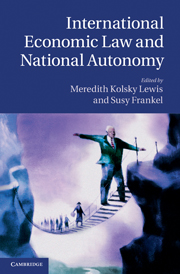Book contents
- Frontmatter
- Contents
- Notes on contributors
- Acknowledgements
- Introduction
- PART I International economic law: conceptions of convergence and divergence
- PART II WTO treaty interpretation: implications and consequences
- PART III Responding to international economic law commitments
- 8 Safety standards and indigenous products: what role for traditional knowledge?
- 9 The GATS and temporary migration policy
- 10 A different approach to the external trade requirement of GATT Article XXIV: assessing ‘other regulations of commerce’ in the context of EU enlargement and its heightened regulatory standards
- PART IV Transformations in international economic law
- Index
- References
8 - Safety standards and indigenous products: what role for traditional knowledge?
from PART III - Responding to international economic law commitments
Published online by Cambridge University Press: 10 January 2011
- Frontmatter
- Contents
- Notes on contributors
- Acknowledgements
- Introduction
- PART I International economic law: conceptions of convergence and divergence
- PART II WTO treaty interpretation: implications and consequences
- PART III Responding to international economic law commitments
- 8 Safety standards and indigenous products: what role for traditional knowledge?
- 9 The GATS and temporary migration policy
- 10 A different approach to the external trade requirement of GATT Article XXIV: assessing ‘other regulations of commerce’ in the context of EU enlargement and its heightened regulatory standards
- PART IV Transformations in international economic law
- Index
- References
Summary
Introduction
Indigenous communities have used native plants as foods and for medicinal purposes for thousands of years. Some of these indigenous products have proven sufficiently popular that individuals outside the indigenous community have sought to consume, purchase and market them. In certain instances, new products have been derived from the indigenous plant and sold outside the indigenous community. In other cases, the indigenous product has been exported in its original form, but utilized in non-traditional ways in the export market. In recent years, various WTO Members have imposed bans and other restrictions on the importation of certain indigenous products on the basis of health and safety concerns. These restrictions tend to be blanket bans on the products as a whole, thus curtailing both the ability to consume indigenous products according to their traditional uses, as well as the adapted versions of such products.
This chapter uses the example of the recent bans on kava from Pacific Island countries as context to argue that the safety of indigenous products with long histories of traditional use should be evaluated on their own merits. They should not be deemed the equivalent of new products with new uses that have been adapted from the indigenous plant, nor should their safety be assessed in combination with such new products. Bans on indigenous products may well be overbroad if they do not differentiate between traditional (quite possibly safe) uses and new (perhaps not-so-safe) uses.
- Type
- Chapter
- Information
- International Economic Law and National Autonomy , pp. 169 - 192Publisher: Cambridge University PressPrint publication year: 2010



